Overview
"Designing for Night-Time Reflection" began as a class project in which my team and I developed design techniques to support individuals reflecting at night. The team conducted interviews and surveys to collect preliminary information.
The team decided to focus on night-time reflection as it was a practice many of us had adopted in our personal lives, and the ideas associated with mindfulness and being able to unwind effectively are incredibly important in our overstimulated lives. Reflection allows people to raise their self-awareness and navigate difficult situations. Although some research has been done surrounding broad concepts such as how to design for reflection, little research has been done that focuses on the specific contexts surrounding the hypnagogic state (e.g, night-time). These motivations led to our preliminary design question:
How can we help people engage in and act upon their night-time reflection?
User Interviews
To approach this over-arching question, the team began by conducting user interviews to answer the following sub-questions:
How do people currently engage in night-time reflection?
What is the emotional experience of reflecting at night?
What are people's attitudes toward using technological interventions (e.g., smartphones) at night?
Each member of the team conducted a semi-structured interview to help begin to answer these questions. Given the personal nature of these questions, the team practiced convenience sampling when conducting these interviews to maximize participant comfort, therefore increasing the likelihood of valuable responses.
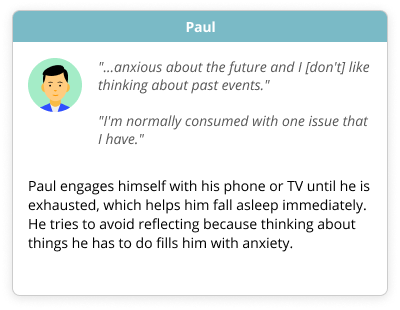
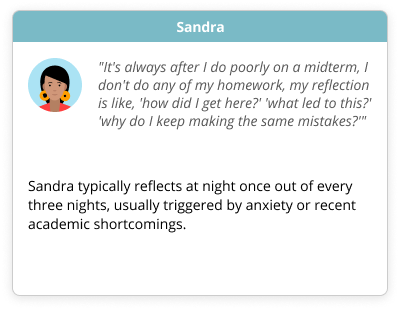
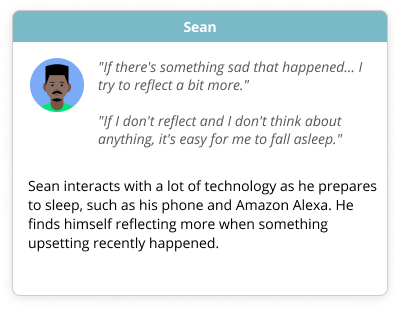
Survey
To evaluate perceptions and experiences with Night-Time reflection on a greater scale, the team created a survey using Google Forms. This survey (n=44) was distributed online via various forums and social groups.
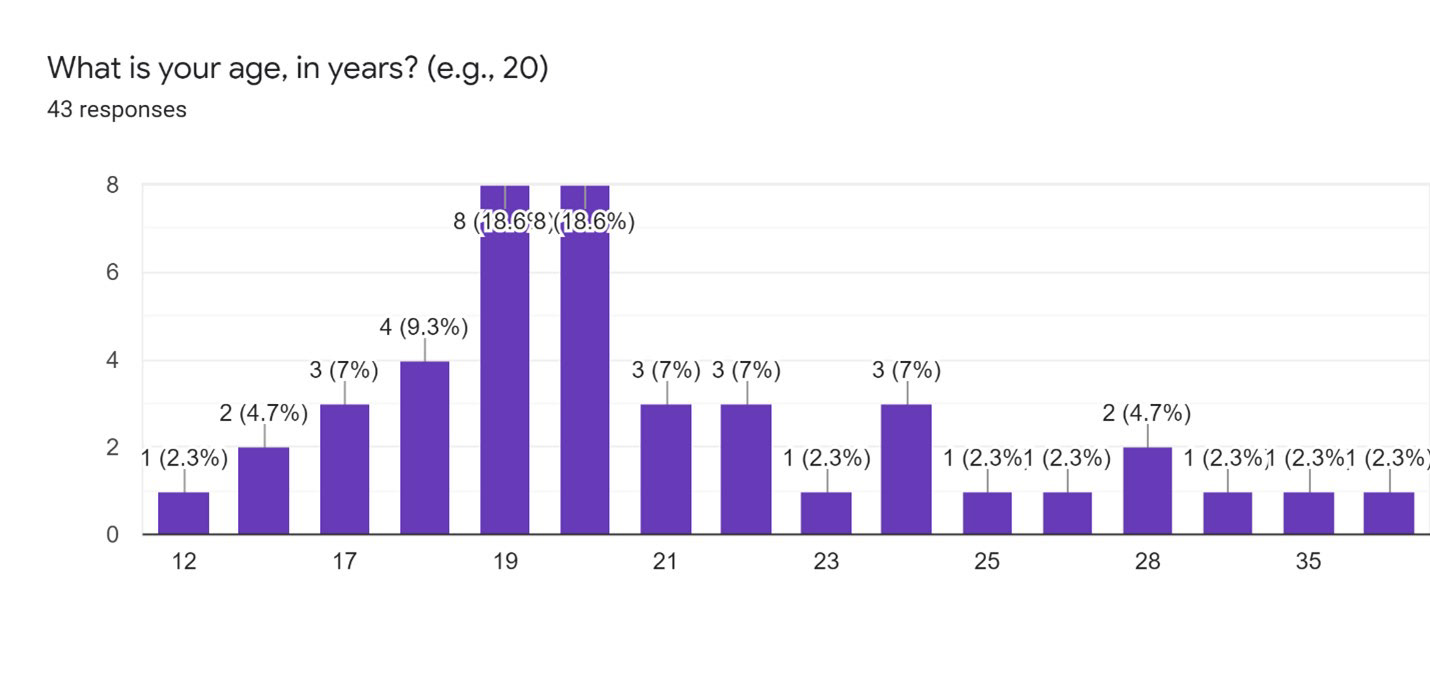
Participants ranged from 12 to 60 years old, with the peak being 19 and 20 years old.
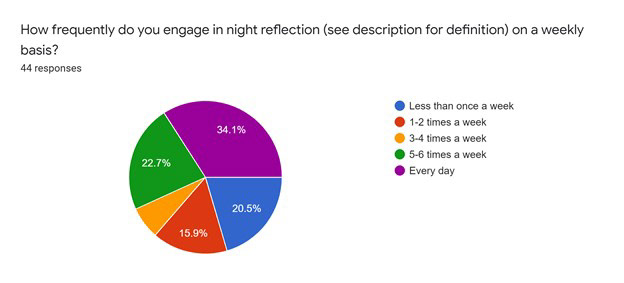
The frequency of engaging in night-time reflection varied greatly, with some participants reflecting every day while others rarely reflected.
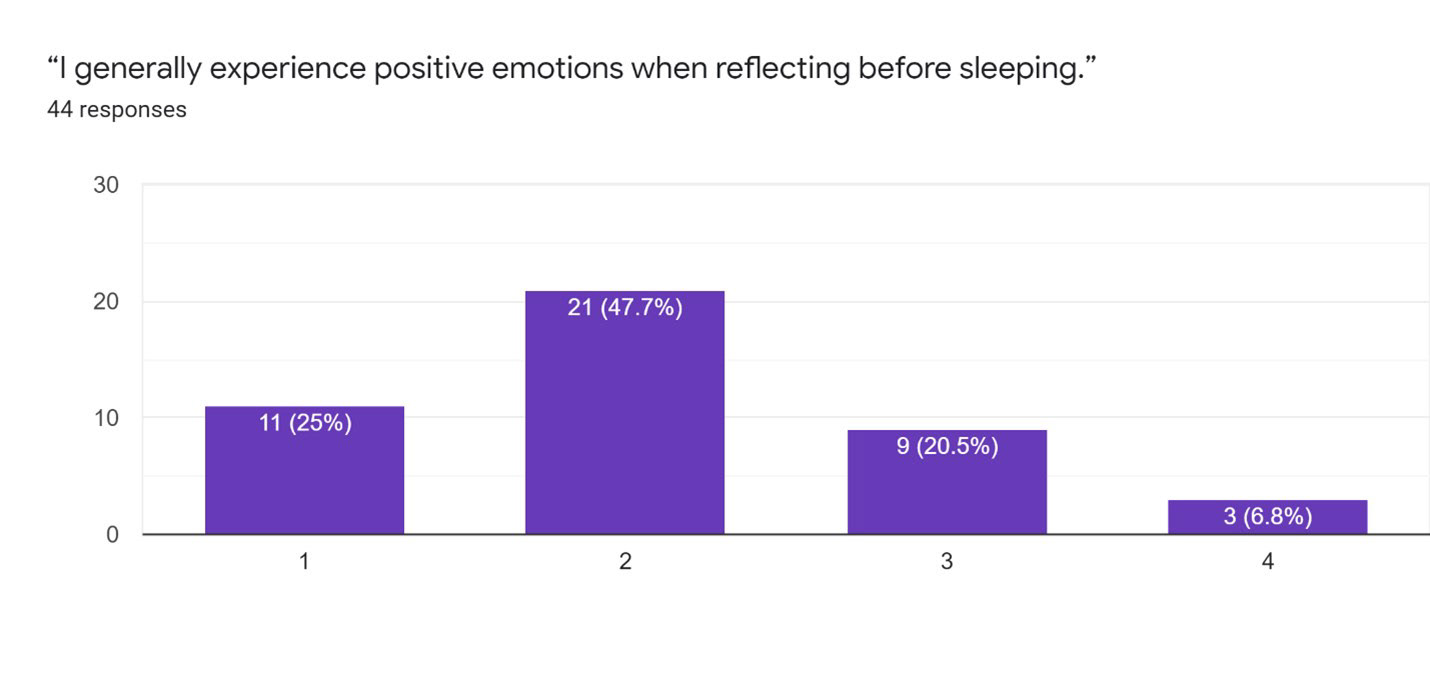
(1 = Strongly Disagree) 29/44 participants found engaging in night-time reflection to be a negative experience.
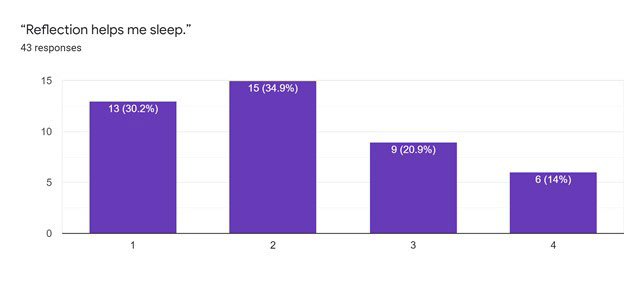
29/43 participants found that engaging in reflection keeps them awake longer.
Survey Findings
Varying attitudes toward technology use in bed
Many participants (28/43) felt that the use of technology before bed reduces their quality of sleep, yet some relied on their mobile phones to record thoughts from reflection. Most participants found that looking at bright screens distracted from their efforts to go to sleep.
Difficulty in acting upon reflection takeaways
Some participants felt frustrated when they failed to act upon their reflection takeaways.
Long reflection hinders efforts to sleep
Spending a long time reflecting reduced participants’ quality of sleep. When they fell asleep quickly, participants mentioned feeling happier and more relaxed in the following day. The possibility of spending an excessive time reflecting influenced participants to prefer avoiding reflection.
Triggers of night-time reflection
Night-time reflective behavior was triggered by a number of factors. Physical and mental fatigue, as well as a dark and quiet environment allowed participants to fall asleep quickly.
Design Requirements
Based on the findings, the team developed a list of design requirements to consider when designing to support night-time reflection.
Avoid screen-based interactions
We stress the importance of non-screen designs as viewing smartphone screens proved to be detrimental to many participants' quality of sleep.
Support users in acting upon reflection takeaways
Designs can support users in taking action by recording thoughts and reminding users of self-set goals.
Consider the negative emotions that might come up in night-time reflection
Before designing, consider whether the design is necessary - is it ethical to urge people to reflect if it often causes negative emotions?
Ideation
Guided by our design requirements the team individually created 10 sketches to outline potential solutions that could help support night-time reflection. Given the unfamiliar circumstances of creating a non-technical interface led to the creation of some rather unorthodox solutions, however these helped frame participant desires and values and assisted the team in the iterations of our final ideas.
Several Rejected Sketches
Next, we compiled our sketches on a Miro board and organized related ideas into categories through affinity diagramming. We then voted on the most promising ideas through dot voting, with each team member being given 7 votes.
These three idea were then fully flushed out and presented to our peers. Whilst each solution attempted to support night-time reflection the feasibility as well as practicality differed amongst the proposals. By correlating each idea with design requirements and discussing our thoughts with peers, the team was able to ensure that our solution would closely align with our design question and support users in engaging in night-time reflection.
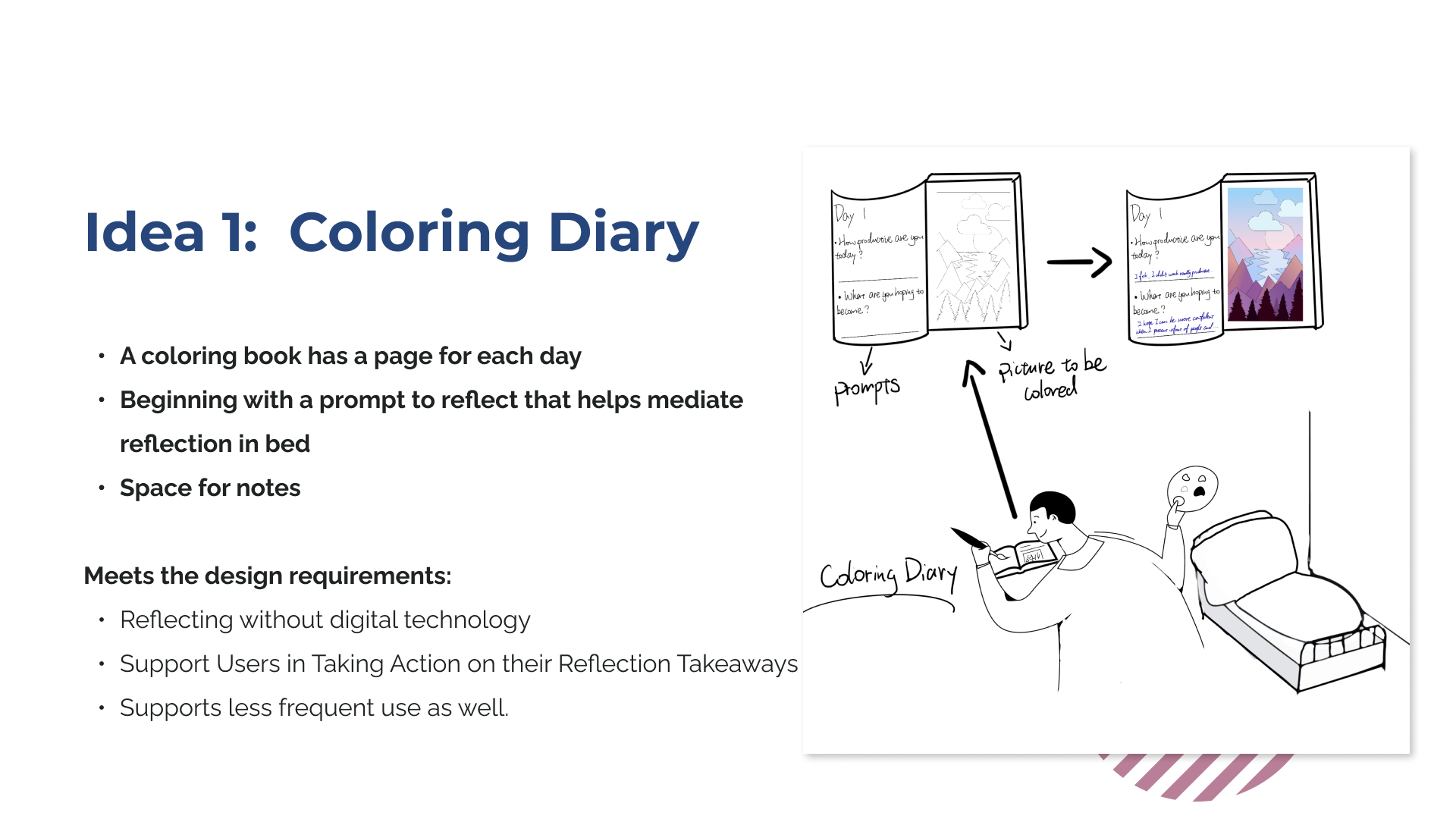
Coloring Diary
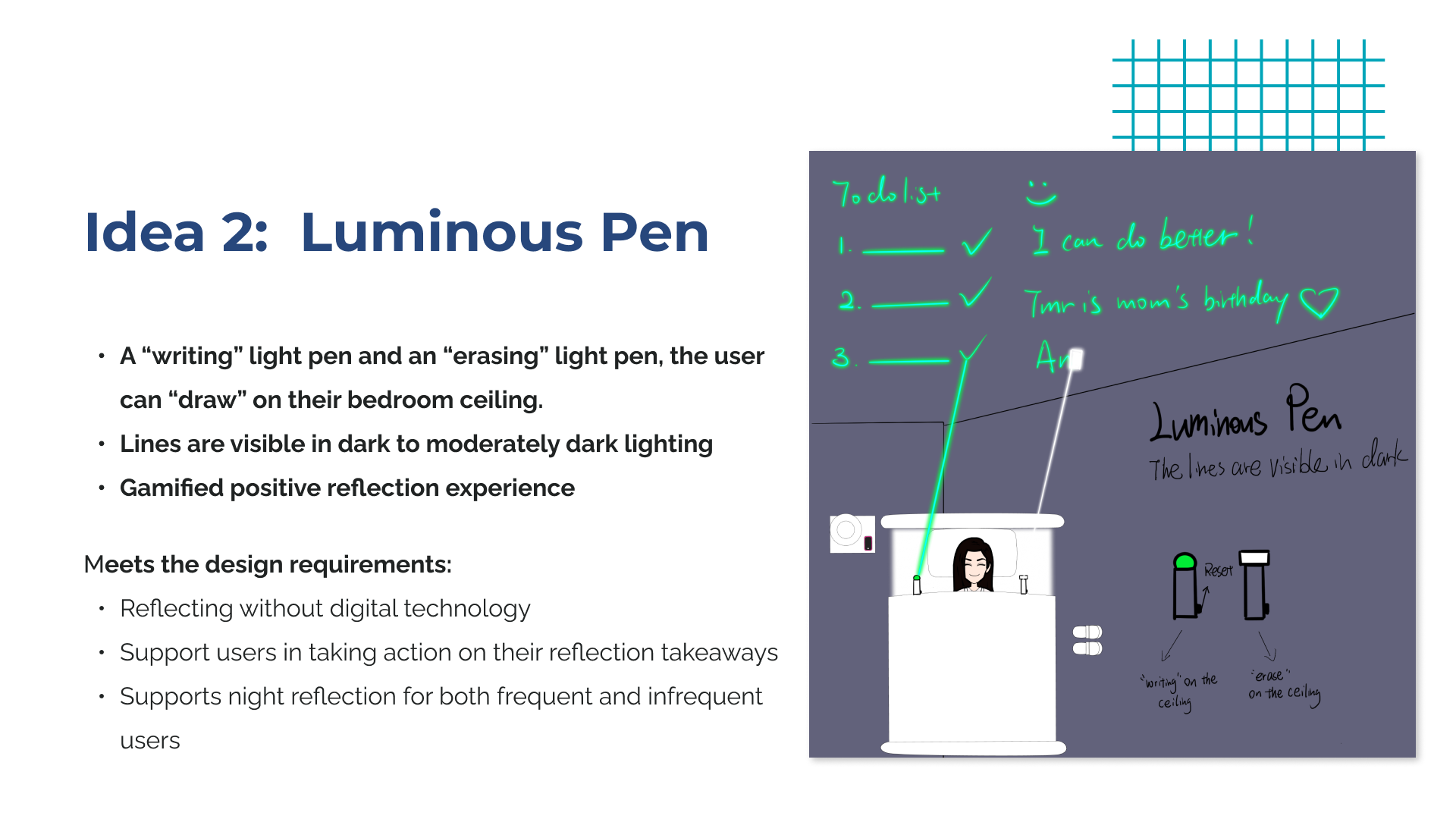
Luminous Pen
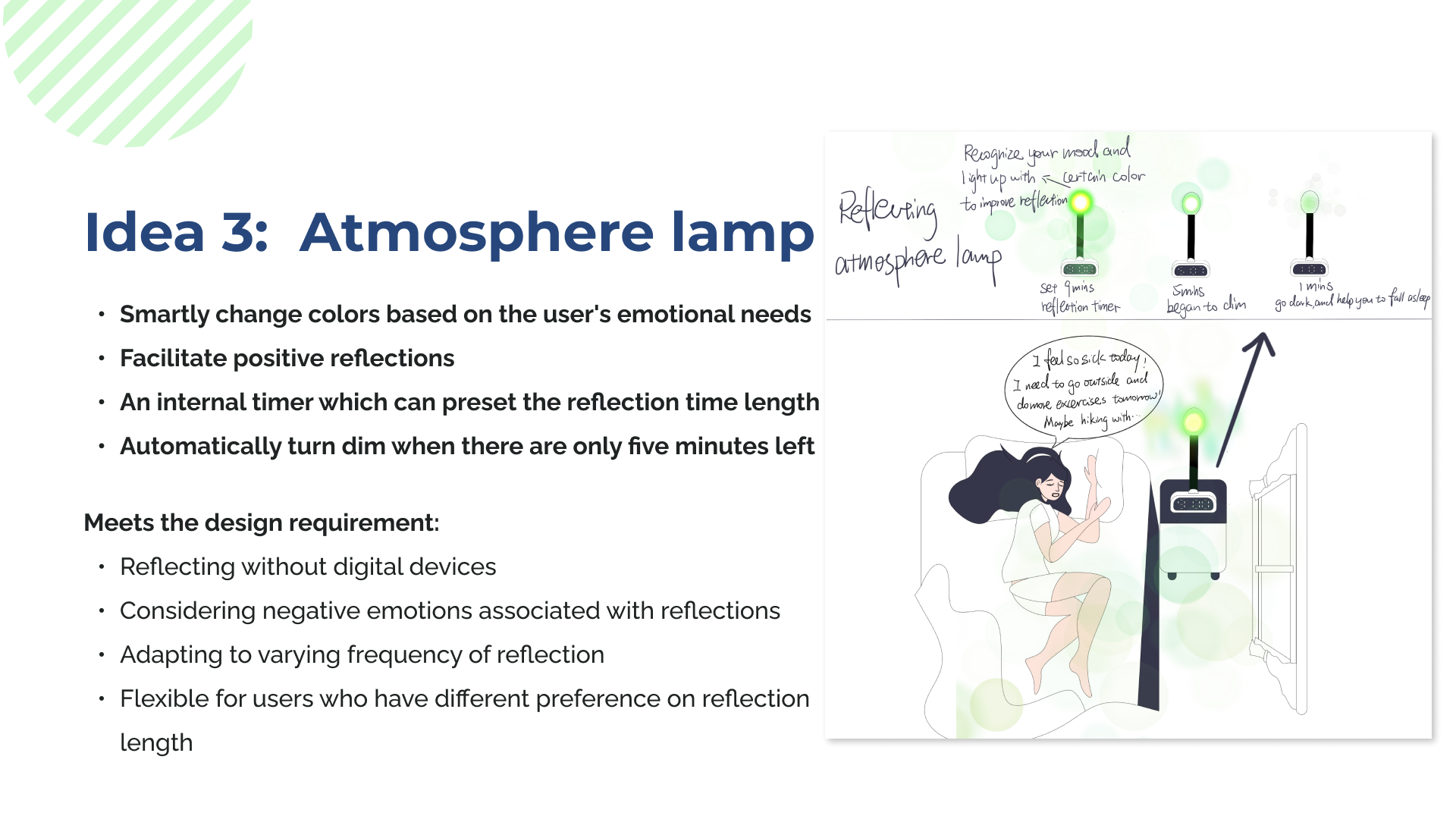
Atmosphere Lamp
Although the team was enticed by the potential of the Luminous Pen and the Atmosphere Lamp, due to limitations in terms of feasibility as well as more limiting use cases, for example people might want to use the product outside of bed, we went ahead and decided to pursue the Coloring Diary idea.
In the first critique session, we asked for feedback from other designers on how effectively this concept supports night-time reflection. Some suggestions that we received to refine this design included:
- Having 365 pages makes it feel like an obligatory task, rather than a relaxation exercise
- Consideration for people who would rather engage in freehand drawing
- Motivation to use diary could wane after seeing the same reflection prompts each time
- Too many interactions can be demotivating
Based on the feedback and suggestions that we received, we refined our prototype with the following changes:
- Have users decide reflection prompts themselves by choosing stickers from the back of the diary
- Step away from having 365 pages for the diary
- Simplify interactions by allowing users to fill in the bubble corresponding to their emotional response, while also maintaining the flexibility of responding in length
With these changes, the second iteration of our prototype was the following:
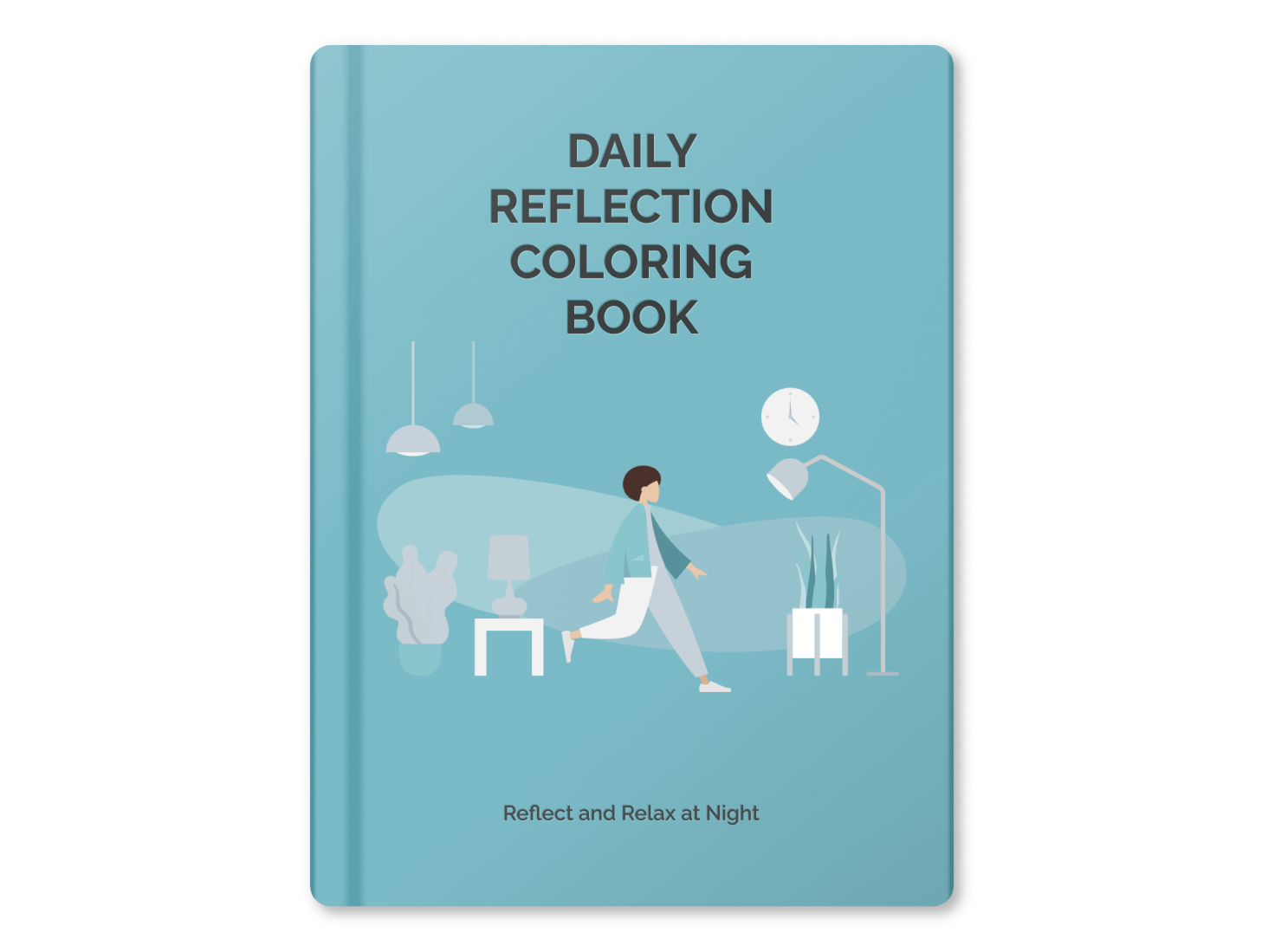
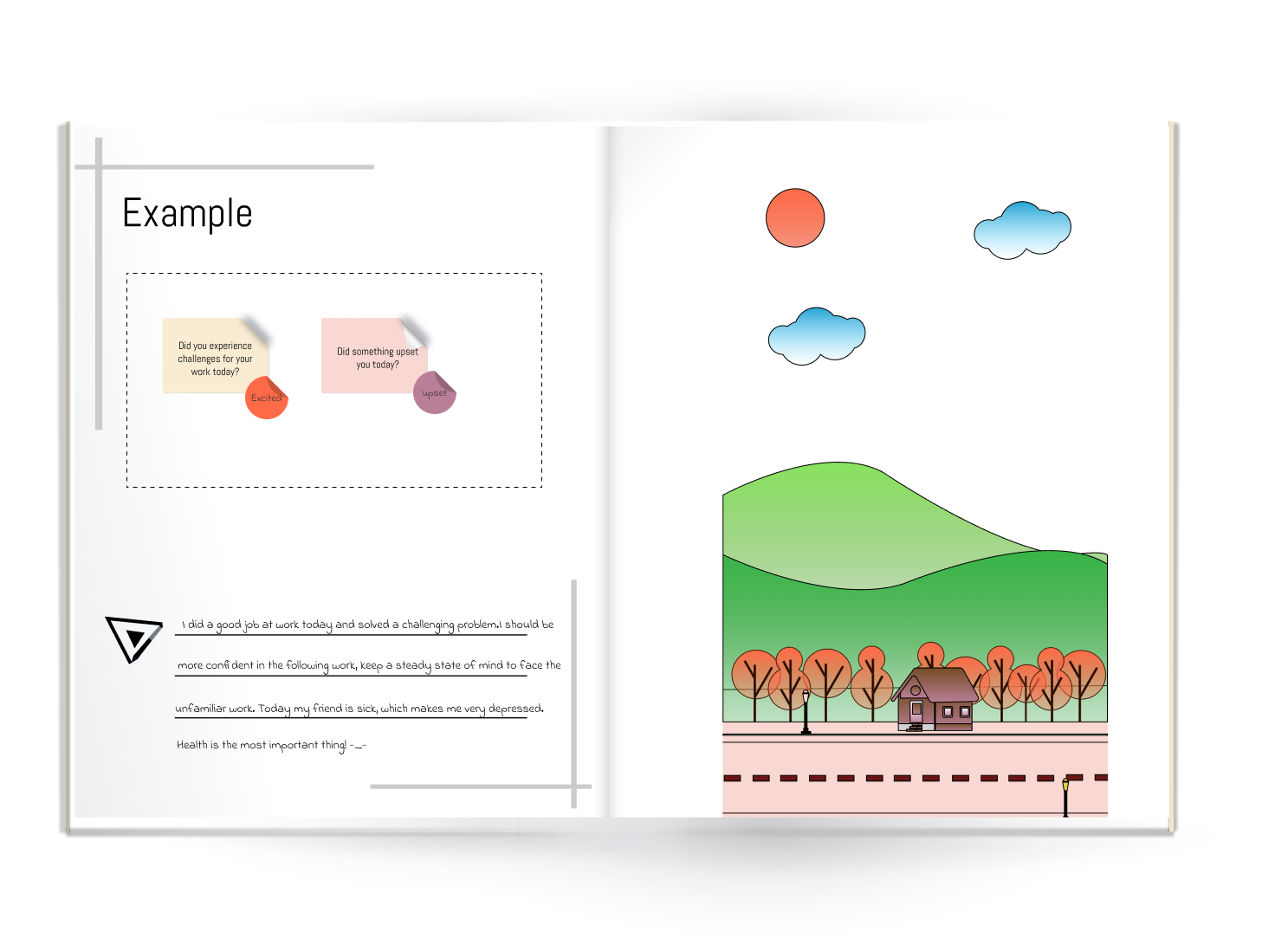
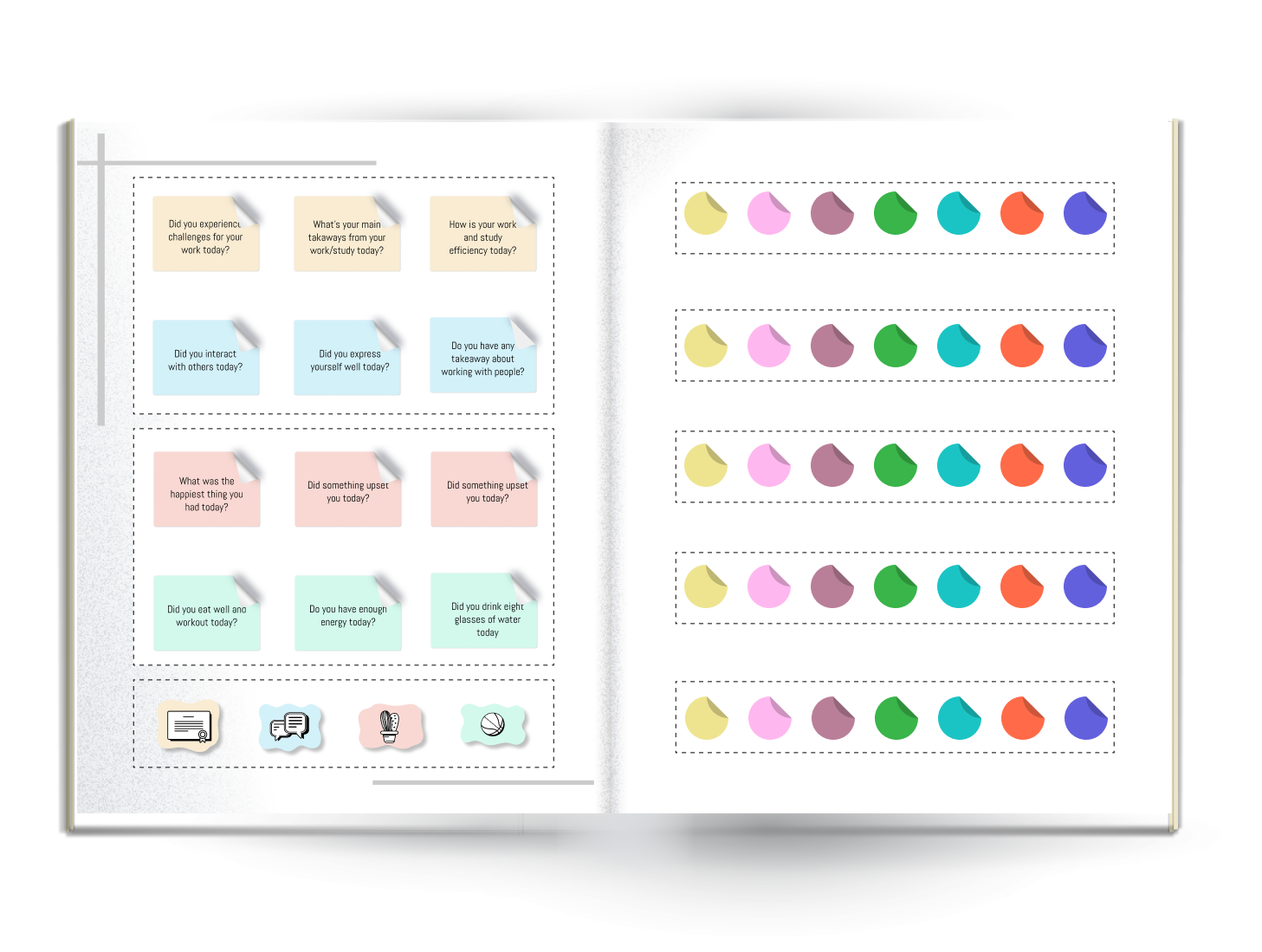
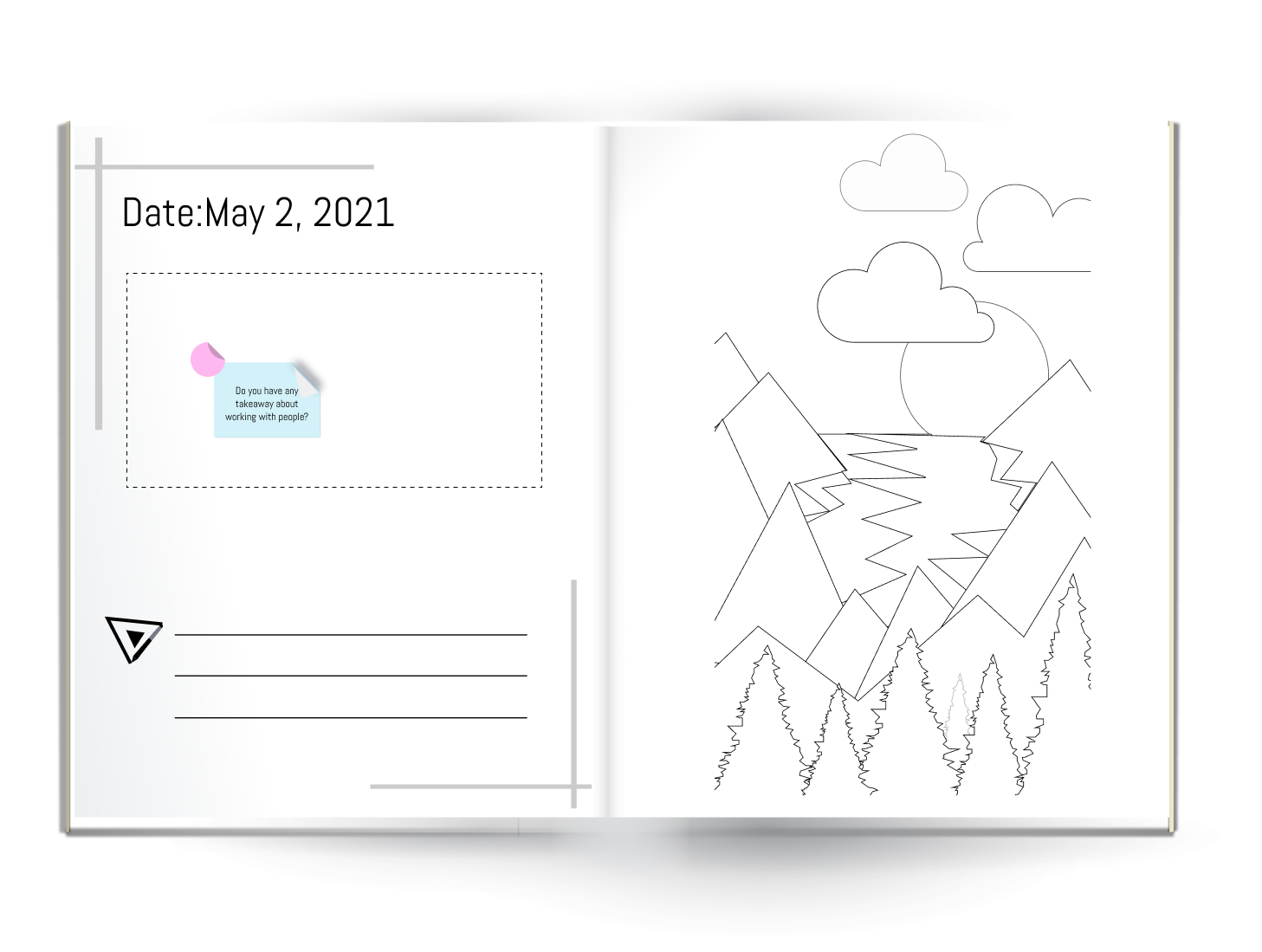
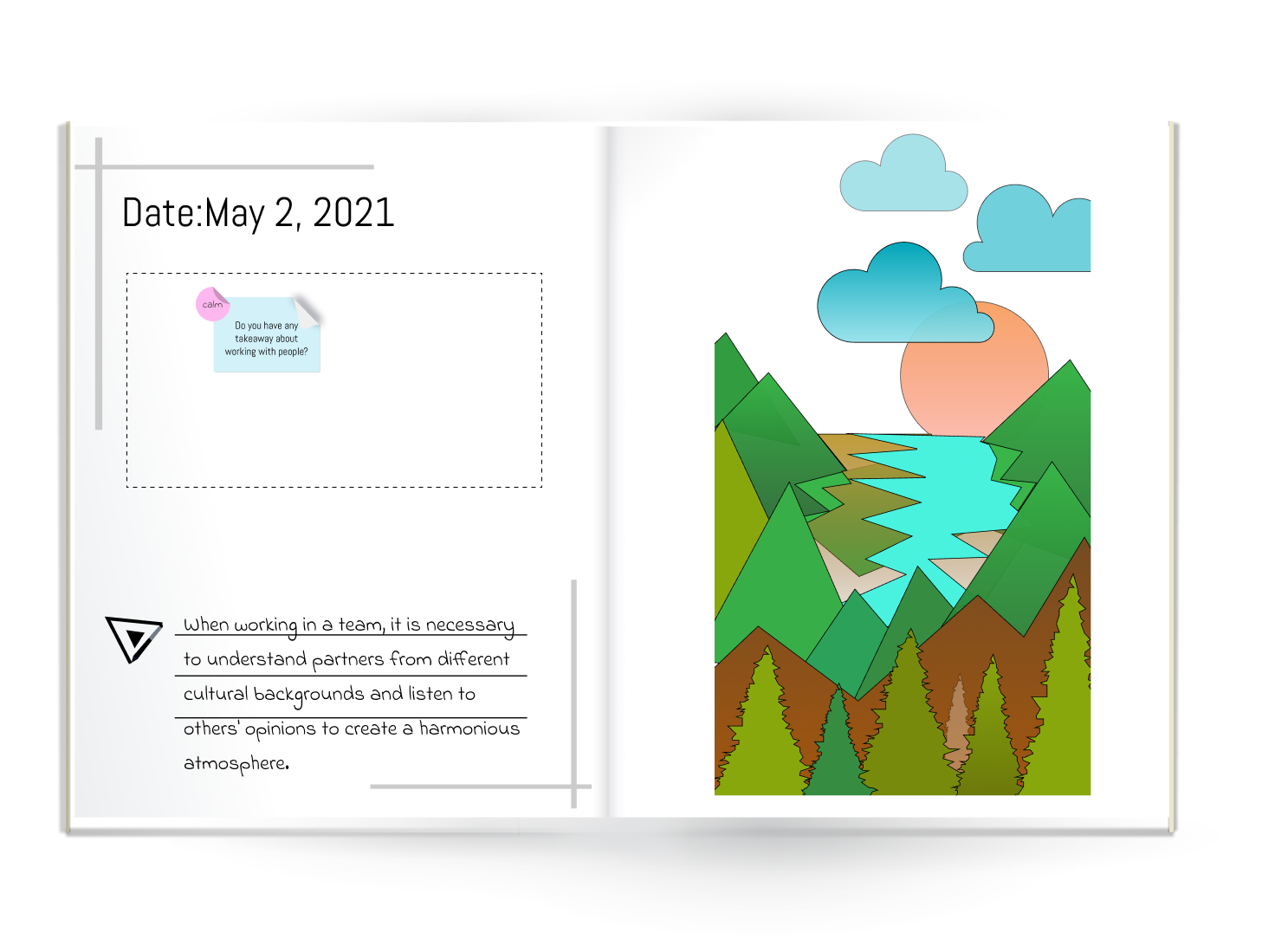
User Testing
With this refined design, we conducted user tests with potential users to test its desirability and usability. We intended the user tests to be explorative, so we rejected the use of an interview protocol to form a conversational environment. Some key feedback from our two user tests include:
- Participants thought that engaging with the diary can be time-consuming and could be difficult to stay awake
- Participants anticipate that motivation for use will wane after awhile due to the repetition of prompts
- Coloring helps them relax and calm down after a busy day
Overall, the participants found the interaction to be a generally positive, engaging experience with minor areas for improvement. User testing was limited in the sense that reflection is a very personal experience so, use of the diary was not entirely representative of how a real world user might employ the diary.
The following changes were made to the final prototype of the reflection diary shown above following the completion of the usability testing:
- To reduce the minimum time spent reflecting, we allowed users to choose how many prompts to reflect on by using stickers.
- We let users dictate what each color represents emotionally by removing prescriptions for each color.
- We gave an example of how to work with the diary to orient first-time users.
Takeaways
Designing for night-time reflection proved to be quite the challenge given the unique requirements associated with the pre-sleep or hypnagogic state. Nowadays as a designer it often feels like the solution to a problem always finds itself in the form of an app, whereas this project allowed me to undergo the full design process, from research, to ideation, to prototyping and evaluating with the limitation of a non-digital system.
The diary that we have created serves as a vessel which users can use to unwind, if they chose to associate their thoughts with emotions, or engage with prompts they may do so. Every user will engage with the diary differently and that's what makes this design so special. By allowing everyone to reflect and unwind in a way that suits them, contributing to healthy and productive habits.
Where this project could have been improved was in terms of user-testing. I believe that part of the success in any service or product lies in retention, and that's especially true in a diary. If a user doesn't use the diary consistently then the value of reflection is limited, and habits struggle to form. If I were to do this project again, and had more time to do so, I would employ the aptly named diary study, to evaluate how users reflect and use the diary over an extended period of time. This would us to see if the diary provides users with everything they need to reflect before bed consistently, and provide insight into patterns of use that might dictate certain elements of the design.